Watching Vitamin C crystal grow – Inspired by Frozen
 Mar 30, 2015 • 9:23 AM UTC
Mar 30, 2015 • 9:23 AM UTC United States
United States 140x Magnification
140x Magnification Non-Living
Non-Living
Manu Prakash
I am a faculty at Stanford and run the Prakash Lab at Department of Bioengineering at Stanford University. Foldscope community is at the heart of our Frugal Science movement - and I can not tell you how proud I am of this community and grassroots movement. Find our work here: http://prakashlab.stanford.edu
266posts
1192comments
42locations
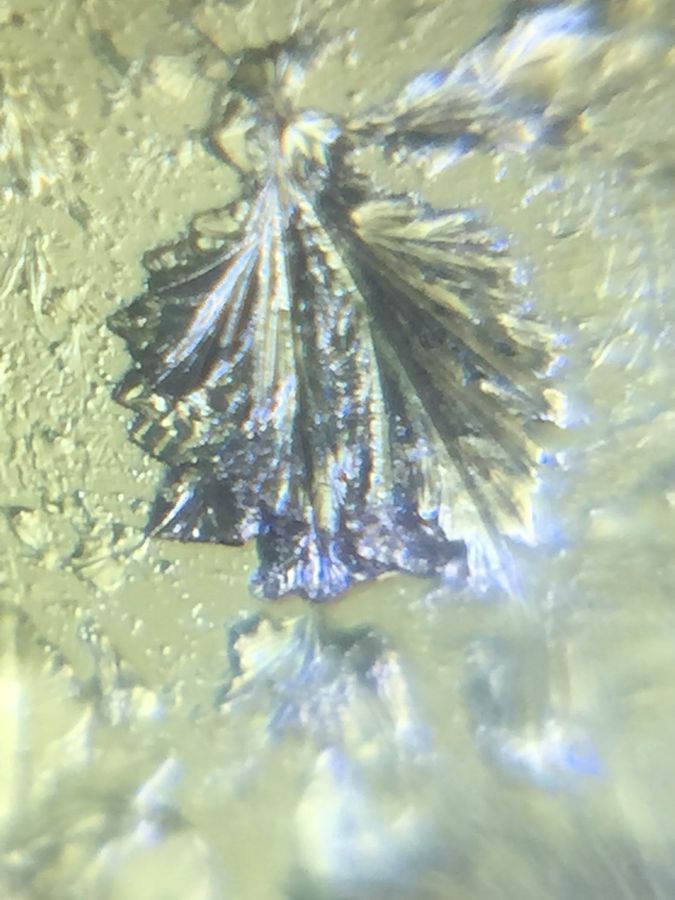
Updated (see note below)
By Manu and Laksiyer
This post will be written as a conversation between two people far away. Just like the originators of the Frozen project 🙂
Manu : Laks, did you know we have incredible group of contributors that started a series of “frozen” projects to explore crystal growth using Foldscope. I have been really inspired by those entries.
Laks : Yes, I have been following those entries. I think they are online – yes here they are:
Part 1: https://microcosmos.foldscope.com/2015/03/03/the-frozen-project-part-1/
Part 2: https://microcosmos.foldscope.com/2015/03/04/the-frozen-project-part-2/
Part 4: https://microcosmos.foldscope.com/2015/03/24/the-frozen-project-part-4/
Part 5: https://microcosmos.foldscope.com/2015/03/26/the-frozen-project-part-5/
Manu : I wanted to contribute to this series.
Laks : that’s a great idea. Why don’t you start with Vitamin C. It’s a very unusual vitamin – most importantly it will dissolve in tap water and thus give you a chance to make some crystals.
Manu : But I really like the beauty of crystals and curious to see how they actually grow. Is it going to be beautiful.
Laks : All crystals are beautiful. You need the right way to look at them. Also, what if you make a time lapse video of the same. I know a fellow named “Mr. William” who posted this note on time lapse microscopy using Foldscope.
http://microcosmos.foldscope.com/2015/02/22/salt-crystals/
Manu : yes, I have heard of Mr. William. He is a very smart fellow. He also likes oscillators..
One day passes. Everyone goes to sleep.. But in the middle of the night, Mr. Manu wakes up… Here are his thought bubbles.
Manu : I need to look at this Vitamin C thing now. I wonder what Laks was talking about..
Maybe if I search my medicine cabinet to see what I want to look at.. After all, it’s the most interesting assortment of chemicals in the house (maybe the kitchen is the second place).
Unaware that we were recording his every move – we wrote down what Mr M. did.
Method:
1. I took a vitamin C tablet and broke it into half.
2. I got a tablespoon full of water and gently scrapped the inside of the tablet. I also dropped one half of the tablet in a tablespoon full of tap water and let it form a cloudy mixture.
3. I removed the undissolved tablet and stirred the mixture very well – to make sure I don’t have any undissolved bits. It did not dissolve completely though – so I did have little seeds new crystals could grow from.
4. I put this solution on a clean glass slide and spread it well; and waited for the water to evaporate and the Vitamin C to form a crystal. I imaged using my Foldscope 140x and iPhone in time lapse mode.
Manu : Laks, look what I got.. Here is the video I got in my first try of the crystal growth;
By Manu and Laksiyer
This post will be written as a conversation between two people far away. Just like the originators of the Frozen project 🙂
Manu : Laks, did you know we have incredible group of contributors that started a series of “frozen” projects to explore crystal growth using Foldscope. I have been really inspired by those entries.
Laks : Yes, I have been following those entries. I think they are online – yes here they are:
Part 1: https://microcosmos.foldscope.com/2015/03/03/the-frozen-project-part-1/
Part 2: https://microcosmos.foldscope.com/2015/03/04/the-frozen-project-part-2/
Part 4: https://microcosmos.foldscope.com/2015/03/24/the-frozen-project-part-4/
Part 5: https://microcosmos.foldscope.com/2015/03/26/the-frozen-project-part-5/
Manu : I wanted to contribute to this series.
Laks : that’s a great idea. Why don’t you start with Vitamin C. It’s a very unusual vitamin – most importantly it will dissolve in tap water and thus give you a chance to make some crystals.
Manu : But I really like the beauty of crystals and curious to see how they actually grow. Is it going to be beautiful.
Laks : All crystals are beautiful. You need the right way to look at them. Also, what if you make a time lapse video of the same. I know a fellow named “Mr. William” who posted this note on time lapse microscopy using Foldscope.
http://microcosmos.foldscope.com/2015/02/22/salt-crystals/
Manu : yes, I have heard of Mr. William. He is a very smart fellow. He also likes oscillators..
One day passes. Everyone goes to sleep.. But in the middle of the night, Mr. Manu wakes up… Here are his thought bubbles.
Manu : I need to look at this Vitamin C thing now. I wonder what Laks was talking about..
Maybe if I search my medicine cabinet to see what I want to look at.. After all, it’s the most interesting assortment of chemicals in the house (maybe the kitchen is the second place).
Unaware that we were recording his every move – we wrote down what Mr M. did.
Method:
1. I took a vitamin C tablet and broke it into half.
2. I got a tablespoon full of water and gently scrapped the inside of the tablet. I also dropped one half of the tablet in a tablespoon full of tap water and let it form a cloudy mixture.
3. I removed the undissolved tablet and stirred the mixture very well – to make sure I don’t have any undissolved bits. It did not dissolve completely though – so I did have little seeds new crystals could grow from.
4. I put this solution on a clean glass slide and spread it well; and waited for the water to evaporate and the Vitamin C to form a crystal. I imaged using my Foldscope 140x and iPhone in time lapse mode.
Manu : Laks, look what I got.. Here is the video I got in my first try of the crystal growth;
Laks : that is fantastic. Next, You should try some higher mag videos.
Manu :yes. I was also able to take pictures of other areas with some very exciting crystal shapes.
Manu :yes. I was also able to take pictures of other areas with some very exciting crystal shapes.
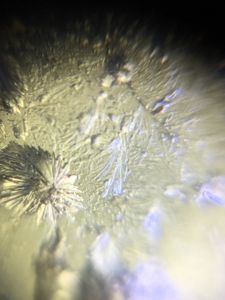
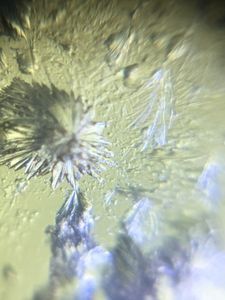
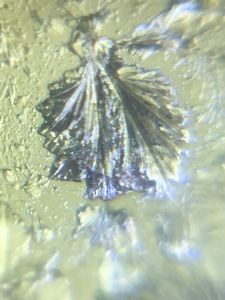
Manu : this one looks like a fern to me.
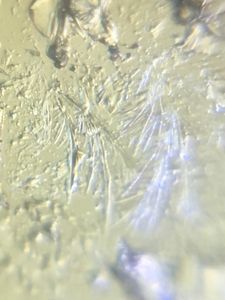
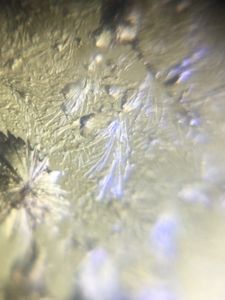
Laks : Now since you have all these beautiful crystals – can I tell you a story.
Manu : yes, I am always ready for a story.
Laks : Vitamin C (ascorbic acid) is essential to life forms and acts as a crucial catalyst in many biological reactions. Since excess Vitamin C is expelled via urine; we need to take Vitamin C dosage regularly.
Manu : I herd, in scientific jargon it’s called 2-oxo- L -threo-hexono-1,4-lactone-2,3-enediol. Imagine if I had o say that every time I wanted someone to pass me a juice 🙂
Manu : oh, also is this why we need to drink that orange juice.
Laks : yes. But what is even more fascinating is that Mice don’t need to take vitamin C. They make it by themselves.
Manu : wow.. Mice are really clever.
Manu : yes, I am always ready for a story.
Laks : Vitamin C (ascorbic acid) is essential to life forms and acts as a crucial catalyst in many biological reactions. Since excess Vitamin C is expelled via urine; we need to take Vitamin C dosage regularly.
Manu : I herd, in scientific jargon it’s called 2-oxo- L -threo-hexono-1,4-lactone-2,3-enediol. Imagine if I had o say that every time I wanted someone to pass me a juice 🙂
Manu : oh, also is this why we need to drink that orange juice.
Laks : yes. But what is even more fascinating is that Mice don’t need to take vitamin C. They make it by themselves.
Manu : wow.. Mice are really clever.
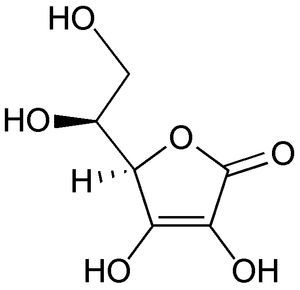
Laks: Vitamin C in animals is synthesized from Glucose through Glucuronate and Gulonolactone. The last step in the biosynthesis is catalyzed by an enzyme known as GULO or GLO (Gulonolactone oxidase). You can see the two-step reaction of GULO in this link .
http://www.genome.jp/dbget-bin/www_bget?rn:R03184+R00647
Manu : I see.. Essentially using an oxygen molecule, two hydrogen atoms are removed from the sugar ring to give a double bond in Vitamin C.
Laks : right. One way to visualize the entire pathway is to use the KEGG database. For example, look at the pathway in rats which make their own Vitamin C.
http://www.genome.jp/kegg-bin/show_pathway?org_name=rno&mapno=00053&mapscale=&show_description=hide
http://www.genome.jp/dbget-bin/www_bget?rn:R03184+R00647
Manu : I see.. Essentially using an oxygen molecule, two hydrogen atoms are removed from the sugar ring to give a double bond in Vitamin C.
Laks : right. One way to visualize the entire pathway is to use the KEGG database. For example, look at the pathway in rats which make their own Vitamin C.
http://www.genome.jp/kegg-bin/show_pathway?org_name=rno&mapno=00053&mapscale=&show_description=hide
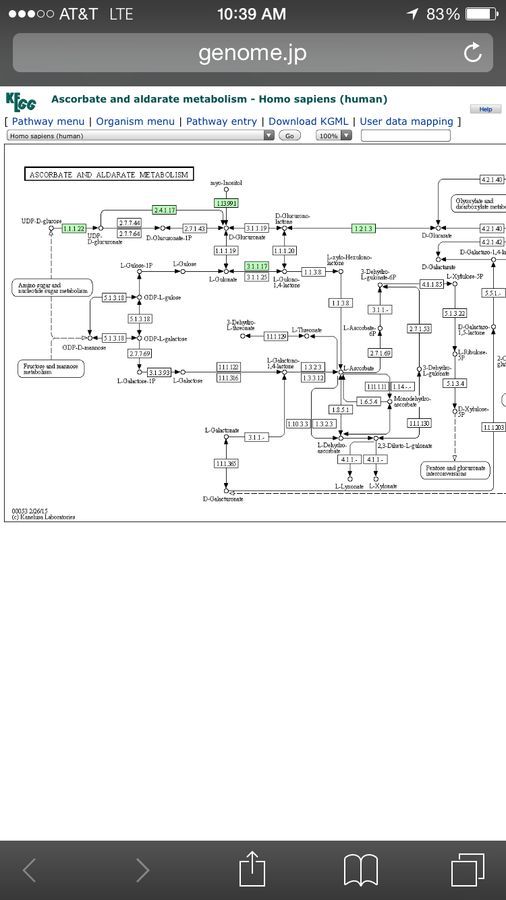
The enzymes that are involved in the synthesis in the rat are shaded green. Now look at the same pathway in humans that dont make it. http://www.genome.jp/kegg-bin/show_pathway?org_name=hsa&mapno=00053&mapscale=&show_description=hide
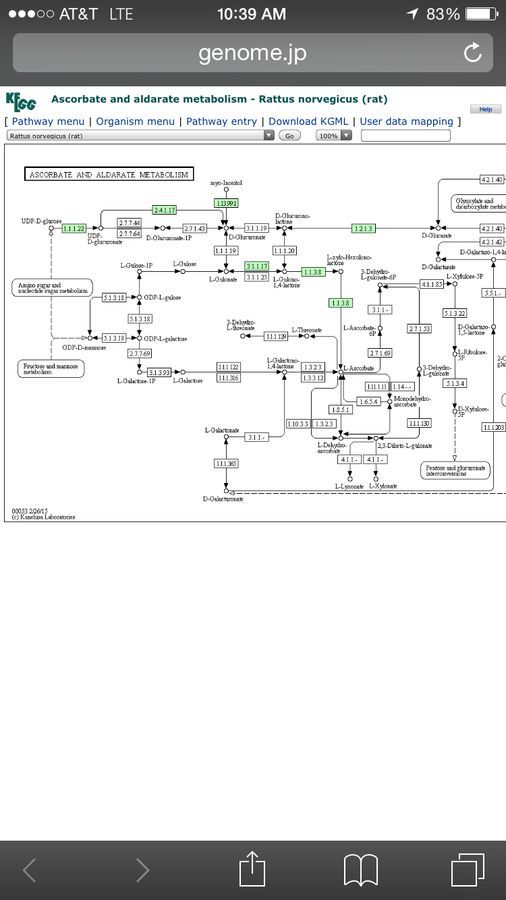
The only difference is the absence in humans of the last enzyme in the ascorbate biosynthesis pathway ( which is numbered 1.1.3.8 in the figure).
Manu : this is so fascinating. I still can’t get over the fact that mice make this essential vitamin and I have to pay for it. It’s not fair.
Laks : Wait a minute. It gets even more interesting. It has been known for sometime that the Vitamin C biosynthesis pathway is often lost in the animals and the distribution of presence and loss is quite intriguing. For example, among primates, all primates with a dry nose (Haplorhini) which includes us dont make it, whereas the Strepsirhini type primates like the lemur make it. Outside the primates, several bat species, guinea pig, passerine birds and teleost fishes also do not make Vitamin C, while most of the others do.
Manu : what about animals from the past.
Laks : Some very ancestral vertebrates like the jawless fish make it. All this suggested that Vitamin C was made ancestrally in the vertebrates and this ability was lost several times in evolution.
Laks : Now some very smart scientists sequenced the GULO gene in the rat and looked for it in humans and found that we too have that gene, but it is mutated in so many places that a functional enzyme cannot be made by it. On the other hand, the enzyme that synthesizes the precursor Gulonolactone is still present in us in an active form. Such is also the case with other dry-nosed primates with which we share many of the mutations in the GULO gene. Now when you put all this together in the context of evolutionary events as we know it today, it appears that the GULO gene was mutated in the common ancestor of all the dry-nosed primates some 63 million years ago when we split from the wet-nosed primates. This great ancestor and its descendants never felt the deficiency as the diet was already a plant-rich one and the Vitamin C synthesis-inability was amply supplemented by the Vitamin C in the plant food. The plant-rich diet continues in our human line and we still keep the defective gene (such genes are called pseudogenes). We would have perhaps not known about this deficiency had it not been for sailors who sailed to distant lands for trade or adventure, and they developed a disease called scurvy due to not eating veggies (unlike Popeye), which they realized could be easily cured by consuming citrus or green leafy vegetables. Over time they figured that the active component which is important in these is vitamin C. So to answer you question, we do have a relic of the gene but it is inactive and hence we have to supplement our diet with Vitamin C. Like us the bats, some passerine birds the guinea pig,have defective GULO., whereas the teleost fish have eliminated it entirely. These species supplement Vitamin C through their diet. Bottom-line is eat your veggies.
Reference . There is a free article below that gives more details.
http://www.ncbi.nlm.nih.gov/pmc/articles/PMC3145266/
Cheers
@Manu and @Laksiyer
Ps : We are trying out a new feature; where now any author of a post can choose a comment that has new information to be part of what they wrote before. I really liked @Laksiyer comments and after his permission, we decided to write a post together. This is a co-authored post by @manup and @Laksiyer.
37.7800004 -122.3894365
Manu : this is so fascinating. I still can’t get over the fact that mice make this essential vitamin and I have to pay for it. It’s not fair.
Laks : Wait a minute. It gets even more interesting. It has been known for sometime that the Vitamin C biosynthesis pathway is often lost in the animals and the distribution of presence and loss is quite intriguing. For example, among primates, all primates with a dry nose (Haplorhini) which includes us dont make it, whereas the Strepsirhini type primates like the lemur make it. Outside the primates, several bat species, guinea pig, passerine birds and teleost fishes also do not make Vitamin C, while most of the others do.
Manu : what about animals from the past.
Laks : Some very ancestral vertebrates like the jawless fish make it. All this suggested that Vitamin C was made ancestrally in the vertebrates and this ability was lost several times in evolution.
Laks : Now some very smart scientists sequenced the GULO gene in the rat and looked for it in humans and found that we too have that gene, but it is mutated in so many places that a functional enzyme cannot be made by it. On the other hand, the enzyme that synthesizes the precursor Gulonolactone is still present in us in an active form. Such is also the case with other dry-nosed primates with which we share many of the mutations in the GULO gene. Now when you put all this together in the context of evolutionary events as we know it today, it appears that the GULO gene was mutated in the common ancestor of all the dry-nosed primates some 63 million years ago when we split from the wet-nosed primates. This great ancestor and its descendants never felt the deficiency as the diet was already a plant-rich one and the Vitamin C synthesis-inability was amply supplemented by the Vitamin C in the plant food. The plant-rich diet continues in our human line and we still keep the defective gene (such genes are called pseudogenes). We would have perhaps not known about this deficiency had it not been for sailors who sailed to distant lands for trade or adventure, and they developed a disease called scurvy due to not eating veggies (unlike Popeye), which they realized could be easily cured by consuming citrus or green leafy vegetables. Over time they figured that the active component which is important in these is vitamin C. So to answer you question, we do have a relic of the gene but it is inactive and hence we have to supplement our diet with Vitamin C. Like us the bats, some passerine birds the guinea pig,have defective GULO., whereas the teleost fish have eliminated it entirely. These species supplement Vitamin C through their diet. Bottom-line is eat your veggies.
Reference . There is a free article below that gives more details.
http://www.ncbi.nlm.nih.gov/pmc/articles/PMC3145266/
Cheers
@Manu and @Laksiyer
Ps : We are trying out a new feature; where now any author of a post can choose a comment that has new information to be part of what they wrote before. I really liked @Laksiyer comments and after his permission, we decided to write a post together. This is a co-authored post by @manup and @Laksiyer.
37.7800004 -122.3894365
Sign in to commentNobody has commented yet... Share your thoughts with the author and start the discussion!

 0 Applause
0 Applause 0 Comments
0 Comments
















